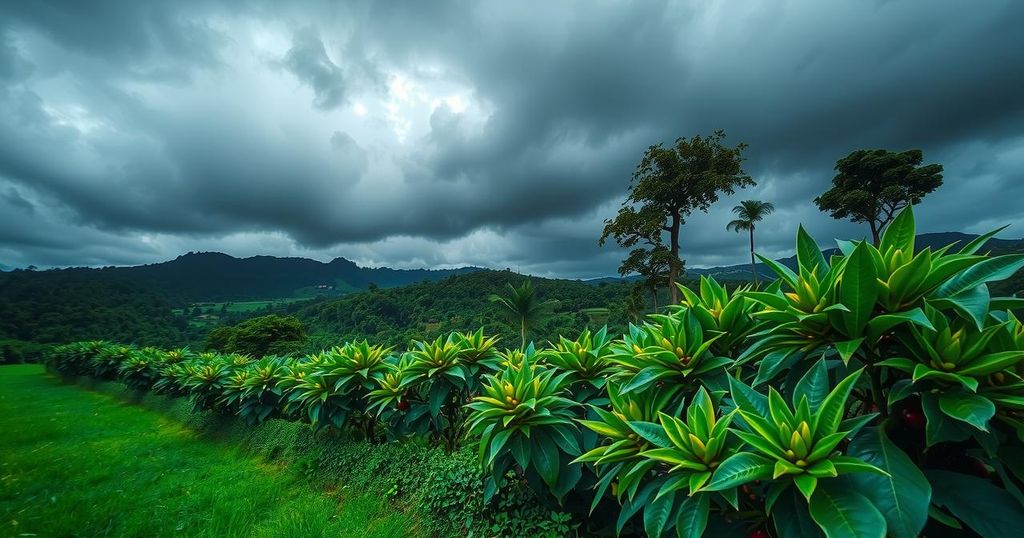Coffee prices fell moderately on predictions of rain in Brazil, with arabica and robusta coffee both declining. Vietnam’s coffee exports showed a year-on-year increase, while inventory levels indicated mixed supply pressures. Concerns over reduced production due to drought persist, influencing the coffee market outlook.
On Friday, coffee prices experienced moderate losses as May arabica coffee (KCK25) closed down by 2.75 cents, representing a 0.71% decline, while May ICE robusta coffee (RMK25) fell 74 cents, equating to a 1.36% decrease. This drop follows predictions of rain in Brazil, with Somar Meteorologia indicating a transition from dry conditions to potential showers next week, which may alleviate drought effects.
Robusta coffee prices are also under pressure from a report by Vietnam’s General Statistics Office, indicating a year-on-year increase of 6.6% in coffee exports for February, amounting to 169,000 metric tons. Furthermore, the forecast of daily rain in Vietnam’s Central Highlands—a key coffee-growing region—has contributed to the declines in robusta coffee prices, as Vietnam leads globally in robusta production.
Stock levels have notably affected coffee prices; ICE-monitored robusta inventories reached a one-month high of 4,356 lots, while arabica inventories decreased to a low of 758,514 bags before recovering to 809,128 bags last Thursday. The fluctuating inventory levels indicate varying supply pressures in the coffee market.
Brazil’s coffee-growing region, Minas Gerais, recorded 11.4 mm of rain during the week of February 22, which is only 24% of the historical average. Continuing supply concerns are backed by reports revealing a reduction in Brazil’s coffee exports and anticipated lower production figures for the upcoming years.
Cecafe confirmed a 1.6% drop in Brazil’s January green coffee exports year-on-year, while Conab projected a decline in Brazil’s coffee crop for 2025/26 by 4.4%. Additionally, the past year’s El Nino-induced drought may cause long-term damage to coffee crops in South and Central America, as Brazil wrestles with the driest conditions in over forty years.
Robusta coffee prices are currently supported by lower production levels, particularly in Vietnam, where the 2023/24 crop year saw a 20% drop in coffee output, marking the smallest harvest in four years. Projections indicate a slight decrease in Vietnam’s robusta production for 2024/25.
Conversely, global coffee export data has shown an increase in Brazilian exports by 28.8% for 2024. However, global coffee exports decreased in December, suggesting a complex market influenced by varying supply and demand dynamics.
The USDA’s biannual coffee report presented a mixed outlook, forecasting a slight increase in overall coffee production for 2024/25 but projecting decreased inventories to levels not seen in 25 years. Additionally, projections for Brazil’s production have been adjusted downward due to worsening drought conditions.
As for the 2025/26 crop year, Volcafe has revised its production estimates significantly, likely leading to a global shortfall in arabica coffee.
Rich Asplund stated that he did not hold any positions related to the securities mentioned in this report. The information provided herein aims to inform and enlighten; for further details, please consult the Barchart Disclosure Policy.
In summary, coffee prices are experiencing downward pressure due to rain forecasts in Brazil and improved export data from Vietnam, despite concerns over reduced inventories and long-term production impacts from drought conditions. The increasing sales of Brazil’s coffee harvest indicate limited immediate supply, while global coffee production estimates remain cautiously optimistic amid prevailing challenges. Overall, ongoing supply concerns continue to shape the coffee market landscape.
Original Source: www.tradingview.com




